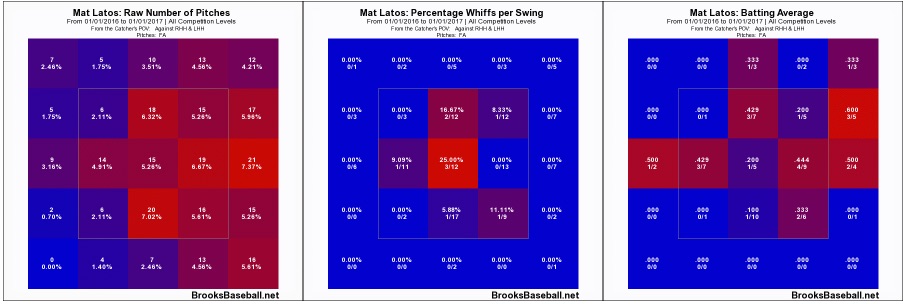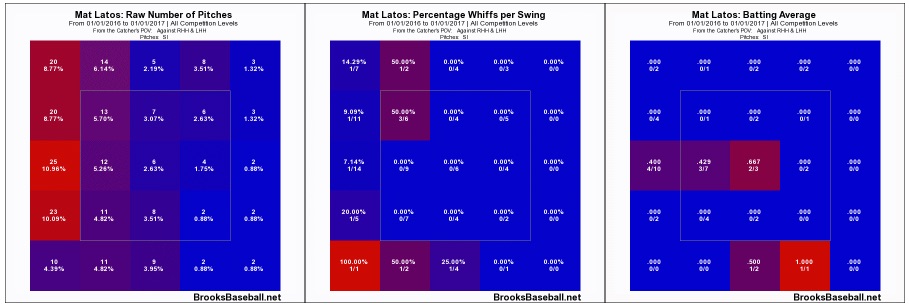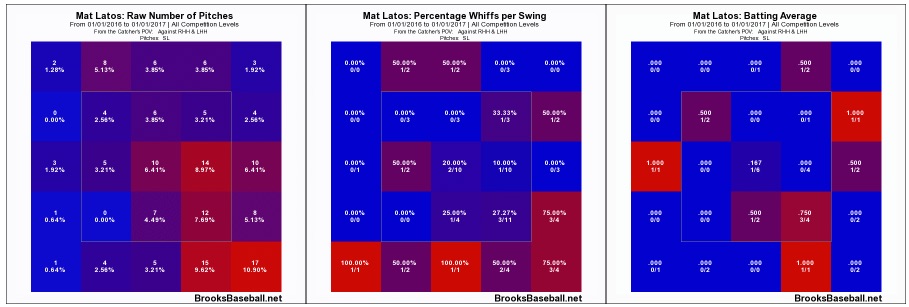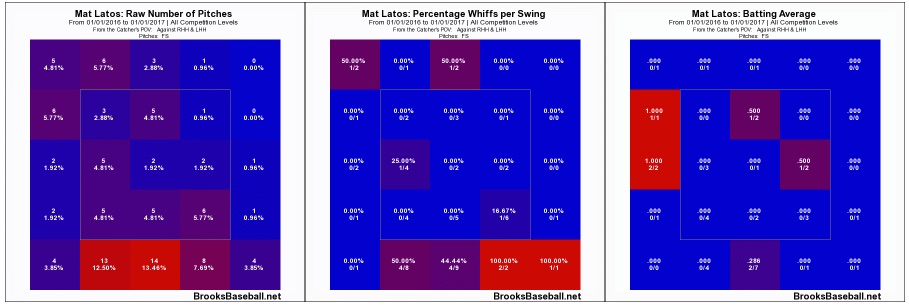In mid-April, after witnessing just a flash of what looked like it had the potential to be a brilliant start from White Sox starter Mat Latos, I wrote about what this stretch that Latos was having could mean for his future success in the White Sox’s rotation.
Well, six weeks later and the question I asked has most likely settled into its inevitable answer: Though the success Latos was displaying lasted until his start in Texas (subsequently, also when everything else began to unravel for the South siders), it appears that now we have seen more bad starts than good, that the real Mat Latos has arrived and might be here to stay.
In the month of April, Latos had a shining ERA of 2.18, struck out sixteen batters, and allowed just six earned runs the entire month. Sure, among those runs were three home runs, but heavier home run totals were something that was anticipated due to Latos’ poor fastball command — something the White Sox were aware of going in.
In May, the major differences in Latos’ performance was abrupt. Latos didn’t see a drop in strikeout rate, as his strikeout rate stayed nearly identical from month to month. It’s common knowledge that these days, Latos is not the type of starter who stacks up the Ks every night. The major difference in May was that Latos saw a drastic rise in his walk rate, coupled with a large decrease in his strand rate — a combination that can never lead to any good. Take a look.
| K% | BB% | LOB% | ERA | FIP | |
| April | 12.6 | 6.7 | 93.8 | 1.84 | 4.35 |
| May | 12.7 | 10.3 | 67.4 | 6.41 | 6.31 |
Some of the numbers Latos posted in April such as his strand rate and ERA were obviously not sustainable for extended periods of time unless he suddenly morphed into Chris Sale overnight, but that being said, I’m not sure anyone expected to see this large of a disparity in his performance from one month to the next.
Command has been a growing concern for those interested in Latos since he injured his knee, which mostly thought to be the origin of his poor mechanics. The problem with the White Sox taking on a pitcher such as Latos, whose main issue is mechanical, is that we can’t be quite sure that the old school, pitching-from-feel master Don Cooper is the man to make the significant changes that Latos needs to succeed in his current form. Latos has it in him, he’s demonstrated that in the past over the course of his seven-year career, and though he’s endured a major knee injury, it’s possible to reinvent yourself on the mound with the proper repertoire and guidance. Latos just has not been able to do that, and his command has suffered for it, something that his new low velocity style of pitching is not equipped to compensate for.
Latos mainly relies on four pitches: his fastball, sinker, slider, and splitter. All of these pitches have flaws that are visible to the naked eye, and could some tweaking to lead to better results. Starting with his fastball and going down the line, let’s look at the major issues each of these pitches has.
Fourseam Fastball
Latos has used his four-seamer 32 percent of the time in 2016, making it his most frequented pitch and of course, his most troublesome. Take a look at the map on the left, his location on all fastballs thrown in 2016. Latos lives high and away to righties, but he also lives pretty much in the middle and upper portions of the zone, something that as the map in the middle characterizes, is not fooling batters. The middle map shows how many whiffs per swing Latos’ fastball is inducing, and as you can see, he’s created virtually zero deception with the pitch, leaving the hitters whiffing on just a neat and tidy area right over the heart of the plate. Finally, the last map shows us which of these pitches batters are making quality contact on, and it’s — as expected for a pitcher who throws his fastball at 92 mph in upper portion of the zone — the high fastballs and the ones Latos leaves right down the middle that get him into trouble.
None of this is very promising for a low velocity, pitch-to-contact type who uses his fastball as often as Latos does. The main reason Latos had a strong stride of success in April with his fastball is because he was keeping it low in the zone, which he something he needs to work to continue. Once May rolled around, Latos began elevating the pitch, and as a result saw his batting average on the pitch rise by 55 points.
Sinker
The location of these sinkers looks odd. That’s because a quality sinker should not be located where Latos is leaving it, and certainly not when it’s his second-most frequented pitch. Latos has thrown his sinker with 25 percent frequency in 2016, and as you can see, it’s not inducing a ton of whiffs when batters are swinging at it. The sinkers that aren’t breaking well and end up being located over the heart of the plate are being crushed, and the ones that Latos is leaving off the plate are going for balls (Latos’ sinker has gone for a ball 38 percent of the time so far in 2016). Hitters are swinging at the pitch with 44 percent frequency, while whiffing on it just under five percent of the time. I know what you may be thinking, ground balls, right? Not really. Latos is only inducing ground balls with his sinker around nine percent of the time.
Latos’ sinker is currently seeing the least amount of vertical break it’s seen in his career, which has something to do with why he’s not seeing the ground ball results you’d expect to see out of the pitch, while the horizontal movement on his sinker has gotten progressively worse over the last four years. More vertical break = more ground balls is the key for Latos on a offering that’s meant to induce contact outs.
Slider
Well, maybe this is a pitch that Latos is seeing bit more luck on: the slider. This is Latos’ third most frequented pitch, thrown 17 percent of the time in 2016. Latos is currently earning a nearly a 15 percent whiff rate on it, but is also allowing a .324 batting average and .559 slugging percentage on it, so maybe not so much luck in contact department. But hey, at least when the pitch isn’t being punished for hanging over the plate, he’s getting batters to swing at it when it’s located low and nearly in the dirt. There’s always a bright side.
Latos’ slider has been all over the plate this season, but in April, he was doing a better job of keeping in the lower half of the zone which led to less of the contact you see in the batting average map above. That’s more indicative of the result he’s seeing when he leaves the pitch high in and around parts of the plate that sliders shouldn’t ever be allowed to see, which has happened more frequently in May. Keeping the slider low and continuing to induce those whiffs is all Latos has to do to see more success with this offering. If only it was that easy.
Splitter
The fourth and final pitch that Latos most frequently uses is his splitter, which he offers at an 11 percent clip. Mostly used as a pitch to chase out of the zone when he’s ahead, Latos actually has a good amount of success with his splitter when it’s well located and has the correct breaking action. As you can see from the batting average maps, that hasn’t been happening all that much, leaving Latos vulnerable to letting runners score when he’s in a two-strike count.
Latos has actually seen a increase in success with the pitch in May, inducing ground balls on it at a 14 percent clip and whiffing batters near 17 percent of the time. So there is at least one pitch that Latos has potential to keep in good standing.
The largest concern with Latos from month-to-month is the fact that he went from having shaky command, but still able to induce good contact outs while keeping the walks to a minimum, to becoming a pitcher who is most likely suffering the plight of mechanical issues rearing their ugly head and making his passable command worse, leading to walks and the inability to hold the runners that he puts on base. Latos is currently seeing the lowest outside the zone swing rate on his pitches of his career, at just 28 percent, as well as the lowest overall swing rate. His swinging strike rate is at just 6.8 percent, a career low, while his contact rate is at a career-high of 85 percent; not exactly a recipe that lends itself to success.
One can only hope that Don Cooper is able to supply the type of assistance that Latos needs to salvage even a decent if unspectacular season on the South side. With John Danks gone and Miguel Gonzalez at this point showing more potential for success, Latos could become the biggest liability in this rotation.
The real question remains however, is he a worse option in the rotation than Erik Johnson, or whomever else is lurking around in Triple-A? I’m not sure I’m quite ready to give you a concrete answer on that yet.
Lead photo courtesy of Mike DiNovo-USA TODAY Sports




